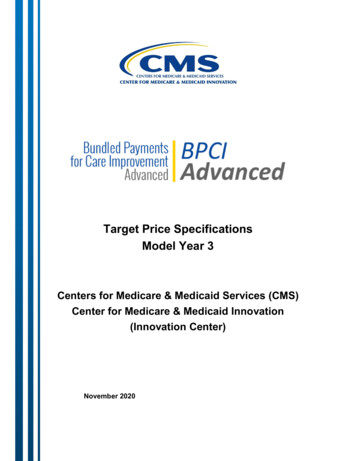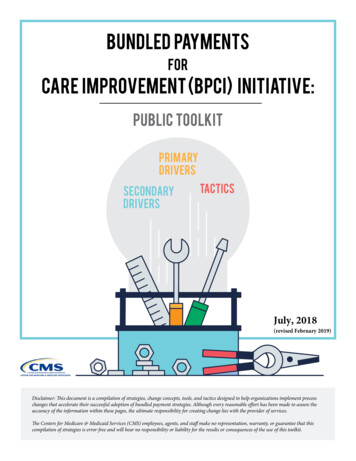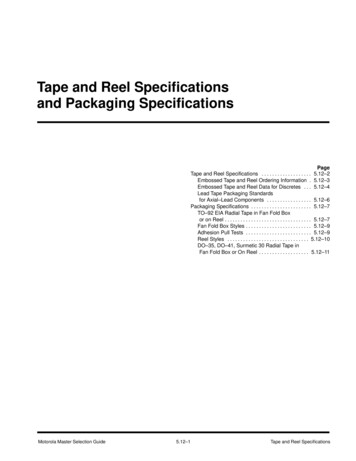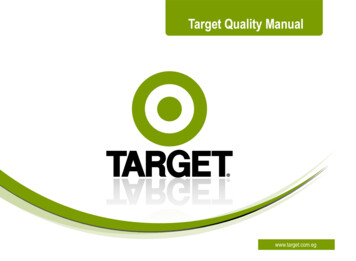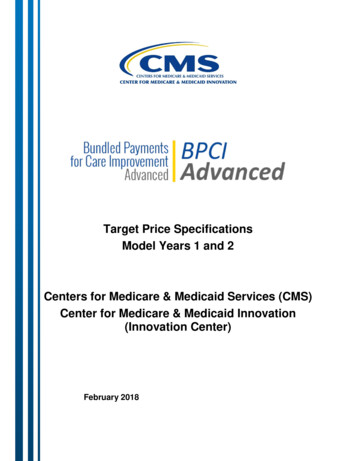
Transcription
Target Price SpecificationsModel Years 1 and 2Centers for Medicare & Medicaid Services (CMS)Center for Medicare & Medicaid Innovation(Innovation Center)February 2018
TABLE OF CONTENTS1234Inputs . 1Target Price Overview . 3Clinical Episode Construction Background . 5Steps In Target Price Construction . 74.1 Patient and Peer Group Risk Adjusters. 74.1.1 Patient Case Mix Adjusters . 74.1.2 Peer Groups. 84.2 Estimate Model of Clinical Episode-Level Spending. 104.3 Obtain ACH and PGP Target Prices . 154.3.1 Formulation of the Preliminary Hospital Benchmark Price . 164.3.2 Formulation of the Preliminary PGP-ACH Benchmark Price . 184.3.3 Create Preliminary and Final Target Prices . 21LIST OF TABLESTable 1: Target Price and Setting-Specific Update Factor Datasets . 1Table 2: Patient Characteristics Categories used to Risk Adjust BPCI Advanced Target Prices. 7Table 3: Peer Group Characteristics used to Construct BPCI Advanced Target Prices . 9Table 4: Clinical Episode Category Level Participant Eligibility Examples . 11Table 5: Model Estimation - PCMA Input Calculation . 13Table 6: Model Estimation - PAT Factor Input Calculations . 14Table 7: Model Estimation - SBS Input Calculations . 15Table 8: Preliminary HBP Calculation . 17Table 9: Components of the Preliminary HBP . 17Table 10: Preliminary PGP-ACH Benchmark Price Calculation . 20Table 11: Components of the PGP-ACH Benchmark Price . 20Table 12: Preliminary ACH Target Price Calculation . 21Table 13: Preliminary PGP-ACH Target Price Calculation . 21BPCI Advanced Target Price Specifications – Model Years 1 & 2 February 2018 ii
1 INPUTSTable 1: Target Price and Setting-Specific Update Factor Datasets#NameSourceDescriptionTarget Price Datasets1234567The national set of Clinical Episodes,constructed using the methodology described inBPCI Advancedthe specifications document. Additional inputsBPCI Advanced Clinical EpisodeNational Clinicalto this file include: Common Working FileSpecifications DocumentEpisodes(CWF), Medicare Enrollment Database (EDB),and Official CMS Standardized AllowedAmounts.The Participant List identifies the Convener,BPCI AdvancedACH and PGP Participants in the BPCICMSParticipant ListAdvanced model.The Provider of Services (POS) Extract iscreated from the QIES (Quality ImprovementEvaluation System) database as of er 2011 and all future POS files. The fileProvider of tains an individual record for each(POS) -approved provider and is updatedquarterly. The file includes information for allinstitutional providers, Ambulatory SurgicalCenters (ASCs), and Clinical -FeeThe file contains information about the factsFor-ServiceProvider Specificspecific to the provider that affect computationsPayment/ProspMedicareFeeSvcPmtGen/psf SFiles (PSF)for Prospective Payment Systems.AS.htmlThe official list of AMCs was created by CMS,Academic Medicalalong with publicly available listings from theCMSCenter (AMC) ListAmerican Association of Academic MedicalCenters (AAMC) and teams of clinicians.The CME contains comprehensive data onindividuals in the Medicare program. ItCommon Medicareprovides information on insurance coverage andEnvironmentCMSMedicare health plan and demonstration(CME)programs in addition to information aboutMedicare Parts A,B,C and non-subsidy Part Dbeneficiaries.Long TermThis file includes information on beneficiariesMinimum DatasetCMSthat are institutionalized long term.(MDS)Setting-Specific Price Update entPPS/FY2018-IPPSThese inputs are used to update historical pricesPayment SystemFinal-Rule-Home-Page-Items/FY2018-IPPSfor the IPPS setting.(IPPS) Base RatesFinal-Ruleand MS-DRGTables.html?DLPage 1&DLEntries 10&DLSWeightsort 0&DLSortDir ascendingBPCI Advanced Target Price Specifications – Model Years 1 & 2 February 2018 1
#91011121314NameSourceDescriptionGPCI e Cost Index Federal-Regulation-Notices-Items/CMS-1676(GPCI), Relative F.html?DLPage 1&DLEntries 10&DLSort 2&DLSortDir descendingValue UnitsRVU/Physician CF:(RVU),These inputs are used to update historical pricesCounty/Locality https://www.cms.gov/Medicare/Medicare-Feefor the PFS setting.Crosswalk, and Value-FilesPhysician andItems/RVU18A.html?DLPage 1&DLEntries Anesthesia10&DLSort 0&DLSortDir descendingConversion FactorsAnesthesia edicare-programRehabilitationThese inputs are used to update historical eFacility (IRF)for the IRF n FactorSee Table 4(most recent csData-and-Systems/Statistics-Trends-andThe MEI is used to update historical prices forEconomic Indexthe “Other” setting.(MEI) (most recent s/20Skilled y (SNF)These inputs are used to update historical idated-billing-for-skilled-nursingfor the SNF setting.Utilization Groupfacilities(RUG) weightsSee Tables 4 and 5Home HealthAgency (HHA)https://www.cms.gov/Medicare/Medicare-Feebase rates andfor-Service-Payment/HomeHealthPPS/Home- These inputs are used to update historical pricesHome HealthHealth-Prospective-Payment-Systemfor the HHA setting.Resource GroupRegulations-and-Notices.html(HHRG) weights(most recent only)Addendum B and Jhttps://www.cms.gov/Medicare/Medicare-Feefrom the Outpatientfor-ServiceThese inputs are used to update historical pitalfor the OPPS setting.Payment ) Final RuleBPCI Advanced Target Price Specifications – Model Years 1 & 2 February 2018 2
2 TARGET PRICE OVERVIEWThe following document describes the methodology used to calculate Target Prices forthe BPCI Advanced model. The BPCI Advanced initiative Target Prices are constructed tosatisfy the following essential features: Encourage both high and low cost providers to participate; Reward Participants’ improvement over time; Adjust for patient case mix that is not under the control of providers; Allow for trends in Clinical Episode spending that are distinct according toproviders’ regions and other relevant provider characteristics; and Induce Medicare savings while maintaining high quality care.To satisfy these essential features, the BPCI Advanced Benchmark Price methodologyincorporates both regional and historical pricing. The methodology brings these elementstogether to provide both those Participants who have been historically efficient and those whohave been historically inefficient with an incentive to lower costs over time and to benefit fromthe financial incentives of the BPCI Advanced model. 1 The methodology achieves this bybenchmarking Participants against other providers with (i) patient populations with similar levelsof expenditure risk and (ii) similar hospital-level characteristics, henceforth referred to as peergroups. 2The methodology produces Benchmark Prices, represented in official CMS standardizedallowed amounts, for acute care hospital (ACH) Participants and for physician group practice(PGP) Participants, each with three components that are multiplied to produce the BenchmarkPrice. Since PGPs will initiate Clinical Episodes at ACHs, PGP Benchmark Prices build uponACH Benchmark Prices to account for the fact that PGPs can initiate Clinical Episodes atmultiple ACHs.The Hospital Benchmark Price (henceforth, HBP) is comprised of the followingcomponents, each of which is described in detail later in this document: Standardized Baseline Spending (SBS): This component accounts for the historicalefficiency of ACHs in the baseline period by calculating risk- and peer-standardizedClinical Episode spending in the baseline period.Efficiency, as defined in Step 8 of Section 4.3.1, refers to lower Clinical Episode spending, relative to otherEpisode Initiators, for Clinical Episodes with the same patient and peer group characteristics.2Peer groups are defined by the list of peer group characteristics within the regression models, as opposed to distinctgroups delineated by a single characteristic. See section 4.1.2 for more information.1BPCI Advanced Target Price Specifications – Model Years 1 & 2 February 2018 3
Patient Case Mix Adjustment (PCMA): This component adjusts for varying levels ofseverity in ACHs’ patient case mix that are outside the control of ACHs. Peer Adjusted Trend (PAT) factor: This component (i) adjusts for persistentdifferences in Clinical Episode spending levels across ACH peer groups and (ii)trends each peer group’s Clinical Episode spending to the Model Year 3 based ontrends in Clinical Episode spending during the baseline period within each ACHpeer group. Peer groups are determined by geographical and hospital-typecharacteristics, described in Section 4.1.2.Similarly, each PGP-ACH Benchmark Price is comprised of the following components: HBP: This component, as described above, provides the basic dollar value of thePGP-ACH Benchmark Price which is adjusted to account for: (i) the relativeefficiency of, (ii) the relative case mix of, and (iii) trends in Clinical Episodespending at, the ACHs at which the PGP initiates Clinical Episodes. PGP Offset: The PGP offset measures a PGP’s historical risk- and peerstandardized efficiency relative to the efficiency of the ACH at which it initiatesClinical Episodes. Relative Case Mix: The relative case mix accounts for whether the case mix of aPGP’s Clinical Episodes at an ACH is expected to be more or less costly than theoverall case mix of Clinical Episodes at that ACH.The result of this methodology is a set of Target Prices that blends Participants’ historicalperformance with trends in each Clinical Episode category’s spending for each peer group. TheTarget Prices reflect each Participant’s level of Clinical Episode spending relative to expectedClinical Episode spending for Episode Initiators with similar patient case mix and othercharacteristics.The following discussion describes the step-by-step implementation of the methodologyused to construct a Target Price for a given BPCI Advanced Clinical Episode category andEpisode Initiator.Since separate Target Prices are not provided for Model Years 1 (2018 Q4) and 2, the single set of prices will betrended to Model Year 2.3BPCI Advanced Target Price Specifications – Model Years 1 & 2 February 2018 4
3 CLINICAL EPISODE CONSTRUCTION BACKGROUNDWhile the purpose of this document is to describe how BPCI Advanced Target Prices arecalculated, this section provides some initial background on the preceding process ofconstructing Clinical Episodes. The Clinical Episode construction specifications describe how toconstruct Clinical Episode-level spending, apply service-level exclusions, convert ClinicalEpisode-level spending to Model Year dollars by applying setting-specific update factors, andcap outlier Clinical Episodes at the 1st and 99th percentiles within each MS-DRG or APC pooledfor each calendar year.The twenty-nine inpatient and three outpatient BPCI Advanced Clinical Episodecategories are identified by an admission in the inpatient setting or a procedure performed in anoutpatient setting initiated by specific MS-DRGs or HCPCS.4 Clinical Episodes are constructedto include all services that overlap the Clinical Episode window, with some exceptions forservices and supplies provided for certain readmissions, which are defined by MS-DRG. 5Clinical Episode-level payments are created by summing official CMS standardized paymentsfor all non-excluded services. 6 These standardized payments reflect the cost of services afterremoving variation in spending arising from geographical adjustment of reimbursement in CMSpayment systems (e.g. hospital wage index and GPCI) and from policy-driven adjustments (e.g.indirect medical education (IME) adjustments). This process produces spending for eachClinical Episode in the baseline period, and henceforth all references to spending are assumed tobe in standardized dollars unless noted otherwise as real dollars.Prior to estimating the model of Clinical Episode spending on data from the baselineperiod, standardized payments for each Clinical Episode are updated to Model Year dollars usingsetting-specific (e.g., IPPS, OPPS, SNF, IRF, or HHA) price update factors. This allows themodel to update the standardized allowed amount that providers would receive based on howinputs have changed in the various Medicare payment systems while holding constant the mix ofservices in the baseline period. This approach, referred to as index price trending, is similar tothe method used to update Target Prices in the Comprehensive Care for Joint Replacement (CJR)model.A complete list of the DRGs and HCPCS that trigger a BPCI Advanced Clinical Episode can be found in the“Episode Definitions – Model Year 1” xls file on ed/.5A complete list of Clinical Episode exclusions can be found in the “MS-DRG Exclusions from Clinical EpisodesList” xls file on ed/6“CMS Standardization Methodology for Allowed Amount, Version 5.” QualityNet - Measure Methodology,Centers for Medicare & Medicaid Services (CMS), Acumen, LLC, 24 Aug. 2016. Available at:http://www.qualitynet.org/dcs/ContentServer?c Page&pagename QnetPublic%2FPage%2FQnetTier4&cid 12287720573504BPCI Advanced Target Price Specifications – Model Years 1 & 2 February 2018 5
These index price-trended historical Clinical Episode spending amounts are in the samestandardized dollar terms as setting-specific prices in the Model Year and represent the basis forcomparing Episode Initiator performance in subsequent sections. 7 Other changes in ClinicalEpisode spending, due to efficiency gains, peer group trends, or changes in patient case-mix, arediscussed in subsequent steps of the model.The setting-specific prices update factors will be re-calculated to reflect the changes in Medicare payment systemsas more recent fee schedules become available during the Model Year of the model.7BPCI Advanced Target Price Specifications – Model Years 1 & 2 February 2018 6
4 STEPS IN TARGET PRICE CONSTRUCTIONThe following section presents the step-by-step methodology used to construct TargetPrices for both ACH and PGP Participants. Section 4.1 describes the risk adjusters used toestimate beneficiary- and peer-adjusted Clinical Episode-level spending. Section 4.2 discussesusing the risk adjustment model to estimate Clinical Episode spending. Finally, Section 4.3outlines how to use model estimates to obtain HBPs and PGP-ACH Benchmark Prices, whichare used to calculate Target Prices.4.1Patient and Peer Group Risk AdjustersFor all Clinical Episodes that overlap the BPCI Advanced model time periods, build arelevant set of patient and peer group characteristics to merge into the Clinical Episode-level file.4.1.1 Patient Case Mix AdjustersBuild the following groups of patient characteristics to merge into the Clinical Episodelevel file, as shown in Table 2. 8 These characteristics were selected to align closely with theCMS v22 Part C HCC and Relative Resource Use HCC (RRU-HCC) models. PreliminaryTarget Price summary workbooks contain coefficients for each risk adjuster included in themodel.Table 2: Patient Characteristics Categories used to Risk Adjust BPCI Advanced TargetPricesRisk Adjuster CategoryData Source/InputSpecificationsHCCsInpatient, Outpatient, and Part BCarrier ClaimsHCCs are constructed using Version 22 of theCMS Medicare Advantage Risk Adjustmentsoftware 9HCC InteractionsInpatient, Outpatient, and Part BCarrier ClaimsHCCs are interacted with each other and otherdemographic characteristics as used in the PACPRD, RRU and Part C ModelsHCC SeverityInpatient, Outpatient, and Part BCarrier ClaimsCount of HCCs for a given beneficiary,categorized into three groups: 1-3, 4-6, 7 Table 2 lists general categories for patient case mix characteristics and does not represent the comprehensive set ofrisk adjusters. CMS may need to add or remove certain elements of the risk adjustment model during constructionof Target Prices.9Software is available at AdvtgSpecRateStats/RiskAdjustors.html8BPCI Advanced Target Price Specifications – Model Years 1 & 2 February 2018 7
Risk Adjuster CategoryData Source/InputSpecificationsRecent Resource UseInpatient, Outpatient, and Part BCarrier ClaimsIndicates whether a Clinical Episode waspreceded by a relevant utilization ofhealthcare servicesDemographicsEnrollment Database (EDB) andCommon Medicare Environment(CME)Includes age, disability as the reason forMedicare entitlement, and dual eligibility forMedicare and MedicaidLong-Term InstitutionalMS-DRG/APCsLong-Term Minimum Data Set(MDS)Indicates whether the beneficiary wasinstitutionalized in a long-term care facility within90 days of the Clinical Episode start dateInpatient and Outpatient ClaimsMS-DRGs are acquired from inpatient claims andmapped from the baseline period to the ModelYear to ensure consistency across years. APCs arebased on HCPCS and are mapped from thebaseline period to the Model Year. 10Outpatient ClaimsComprehensive APCs are taken from Addendum Jof the OPPS Final RuleInpatient ClaimsClinical Episode category specific risk adjusterssuch as fracture 11 indicator for Major JointReplacement of the Lower ExtremityComprehensive APC(Outpatient ClinicalEpisode CategoriesOnly)Clinical EpisodeCategory SpecificAdjustments4.1.2 Peer GroupsConstruct ACH peer group characteristics using the following methodology, as shown inTable 3. Merge peer group indicators to the Clinical Episode-level files based on the ACH of theClinical Episode.10IPPS and OPPS Final Rules as well as OPPS addenda are u
Table 12: Preliminary ACH Target Price Calculation . 21 Table 13: Preliminary PGP-ACH Target Price Calculation . quarter 2011 and all future POS files. The file contains an individual record for each Medicare-approved provider and is updated quarterly. The file includes information for allFile Size: 574KB
